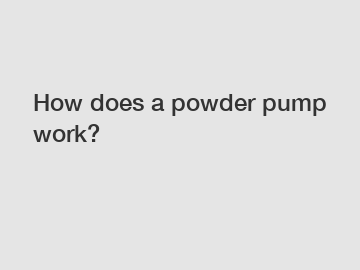How does a powder pump work?
Have you ever wondered how powders are transferred from one location to another in industries such as food, pharmaceuticals, or chemicals? The answer lies in a piece of equipment known as a powder pump. Powder pumps play a crucial role in efficiently handling and transporting powders in a variety of industrial processes. In this blog post, we will delve into the inner workings of a powder pump and explore how it functions.
Powder pumps, also known as powder transfer pumps or pneumatic vacuum conveyors, are designed to transfer powders from one point to another within a manufacturing facility. These powders can range from fine powders such as flour and sugar to more granular materials like cement and chemicals. The pump operates by creating a vacuum that pulls the powder into a chamber and then uses compressed air to push the powder out through a discharge nozzle.
The key components of a powder pump include an inlet hopper, a conveyance chamber, an airlock valve, a discharge nozzle, and a control system. The process begins when the powder is loaded into the inlet hopper, which feeds the powder into the conveyance chamber. The powder is then entrained in a stream of air that is generated by a vacuum pump located at the opposite end of the conveyance chamber. This air stream helps to keep the powder suspended and moving towards the discharge nozzle.

The airlock valve plays a crucial role in regulating the flow of powder into the conveyance chamber. It ensures that the powder is transferred in a controlled manner and prevents backflow or leakage. The discharge nozzle, on the other hand, is responsible for ejecting the powder out of the pump and into the desired destination, such as a mixer, packaging machine, or storage container.
The control system of the powder pump is essential for monitoring and adjusting the various parameters of the operation, such as the vacuum level, air pressure, and flow rate. This control system can be automated to maintain consistent performance and efficiency throughout the manufacturing process.
So, how does a powder pump work in practice? Let's take a closer look at the steps involved in transferring powder using a powder pump:
Step 1: Loading the powder - The operator loads the powder into the inlet hopper of the pump. It is essential to ensure that the powder is properly sieved and free from any lumps or contaminants to prevent clogging in the pump.
Step 2: Creating a vacuum - The vacuum pump is activated to create a negative pressure in the conveyance chamber, which helps to pull the powder into the chamber and keep it suspended in the air stream.
Step 3: Conveying the powder - The powder is transported through the conveyance chamber towards the discharge nozzle using the air stream generated by the vacuum pump. The airlock valve controls the flow of powder and prevents any air leakage.
Step 4: Ejecting the powder - The powder is ejected out of the pump through the discharge nozzle and into the desired destination, such as a mixer or packaging machine. The flow rate and pressure can be adjusted using the control system to optimize the transfer process.
Overall, powder pumps offer a reliable and efficient solution for handling powders in various industrial applications. They provide a cost-effective and hygienic method of transferring powders without the risk of contamination or spillage. By understanding how a powder pump works, manufacturers can improve their production processes and ensure the seamless transfer of powders from one point to another. Whether you are in the food, pharmaceutical, or chemical industry, a powder pump can help streamline your operations and enhance productivity.
If you are looking for more details, kindly visit Liquefaction pump, pneumatic piston pump manufacturer, pneumatic diaphragm pump how it works.
93
0
0


Comments
All Comments (0)